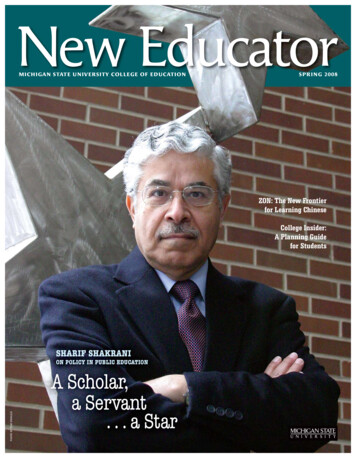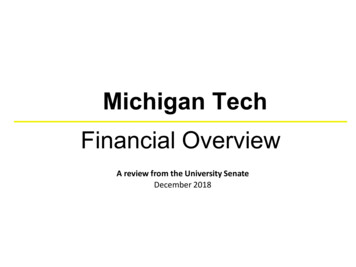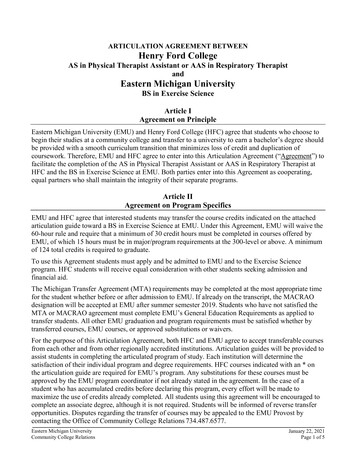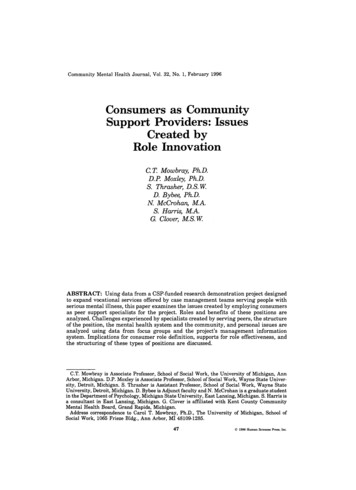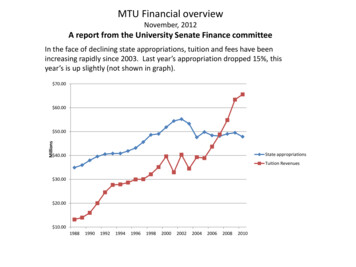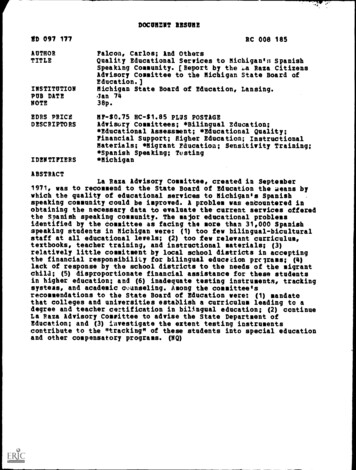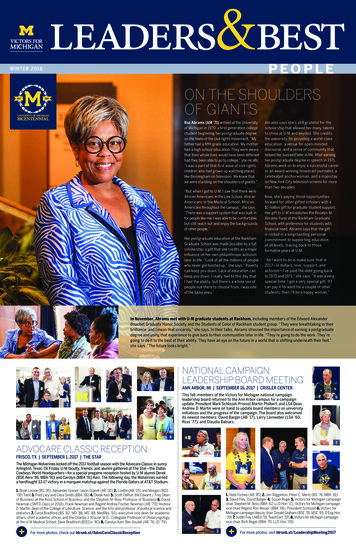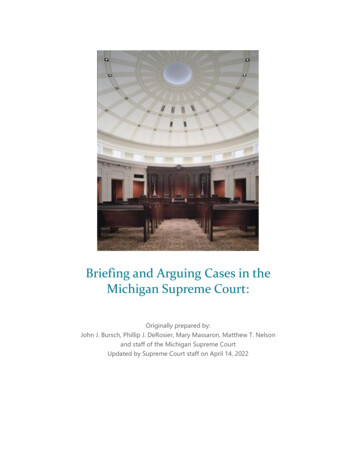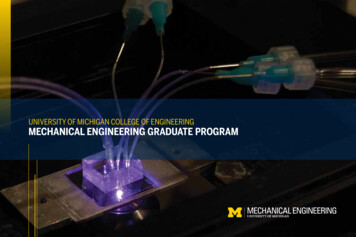
Transcription
UNIVERSITY OF MICHIGAN COLLEGE OF ENGINEERINGMECHANICAL ENGINEERING GRADUATE PROGRAM
MECHANICAL ENGINEERING GRADUATE PROGRAMThe new Mechanical Engineering ResearchComplex: a state-of-the-art world-classfacility.01WELCOME TO U-M MEA Top-Ranked GraduateProgram!Mechanical Engineering (ME) at the Universityof Michigan (U-M) is consistently rankedamong the very top programs in the nationand in the world. Based on data analyzed andpublished by the National Research Council(NRC), our PhD program received an overall#1-2 ranking from the independent websitePhDs.org, using weightings of the NRC datafor large institutions. Our multidisciplinaryapproach to research and learning combinestrendsetting research with challengingcoursework and leadership opportunities.The international reputation of the Universityof Michigan ensures access to world-classprofessors and the most up-to-date facilities,and the beautiful town of Ann Arbor is a greatplace to live and work.This book will give you a quick overview of ourtop-notch research and graduate programs,the University of Michigan, and lovely AnnArbor. Profiles of some of our alumni areincluded as well. For more detailed information,please visit our website at me.engin.umich.edu.Enjoy your reading!
02MECHANICAL ENGINEERING GRADUATE PROGRAMMECHANICAL ENGINEERING GRADUATE PROGRAMAn Education Program forResearchNot all graduate programs are created equalwith respect to research opportunities andearly engagement in research. Roughly 50%of master’s students in U-M MechanicalEngineering are involved with an independentresearch project or a thesis. The Master’sprogram enables students conducting researchto tailor their course structure to allow themto learn the analytical and experimentaltechniques that prepare them to contributequickly to cutting edge research. At the PhDlevel, the qualification examination processinvolves individualized graduate courseworkthat supports each student’s particular researchtopic. Due to this synergy between researchand coursework as well as valuable mentoringopportunities and a strong graduate studentpeer community, nearly all students becomePhD candidates by their fourth semester inthe program. This quick start is a hallmark ofa program known for putting students on theleading edge of scholarly contributions and realworld impact, as well as graduating studentswith a plethora of job opportunities in academia,industry, and government.Program OverviewOver the years, graduate students have chosenthe Michigan program because of its outstandingreputation in research scholarship, innovationand impact, its consistent record of pushing MEfrontiers and its exceptional rapport with students.As an ME graduate student, you’ll become partof a vibrant community that includes student-runorganizations such as the ME Graduate Council,the Graduate Society of Women Engineers, andthe National Society of Black Engineers, to namea few. These organizations enable students toleverage professional networks and gain access toa social community that provides support for therigorous pace of graduate engineering studies.The Michigan graduate program in MechanicalEngineering offers two degrees: a Master of Sciencein Engineering (MSE) and a Doctor of Philosophy(PhD). You can also pursue dual degrees—forexample, in the Engineering Sustainable Systemsprogram with the School of Natural Resources &Environment or with other programs within theRackham Graduate School. In addition, qualifiedundergraduates in the College of Engineeringcan pursue a combined undergraduate/graduatedegree in the Sequential Undergraduate/GraduateStudies (SUGS) program.03
04MECHANICAL ENGINEERING GRADUATE PROGRAMMaster’s Degree (MSE)Students choose to pursue a master’s degreebecause of the opportunity to develop a personalizedacademic program to strengthen their knowledge ofME fundamentals in a specific area. There are threeseparate MSE degree program options: courseworkonly, coursework plus an individual research project,and coursework plus an MSE thesis.Doctor of Philosophy (PhD)The goal of the PhD program is to create a culture ofscholarship and high-impact research that producesarticulate researchers who are called upon first tohold leadership positions in society and academia.The PhD is the highest degree awarded by the MEDepartment and is recommended for students whoare interested in leadership careers in academia(e.g., as a university faculty member), industry, orgovernment. PhD graduates are trained to be theleaders and best in their fields and have doors open toa wide selection of career tracks. PhD students beginresearch immediately and have access to coursesand networks that support their research progress.ME is also a partner with the Rackham GraduateSchool, which offers workshops, training sessions,forums, and talks relevant to graduate students.MECHANICAL ENGINEERING GRADUATE PROGRAM05Research AreasBIOSYSTEMS AND BIOMECHANICS:From Cells to PeopleBiosystems and biomechanics research offers aninterdisciplinary study of diverse biological phenomenaacross many size scales, from single DNA/proteinmolecules to cells and tissues and to human organsand the body. Students apply engineering andphysical principles to study molecular, cellular, andtissue biomechanics; construct miniaturized fluidicsystems for biomedical diagnostic applications; anddevelop medical devices for rehabilitation. The closeproximity of the world-renowned U-M Medical Schoolenables seamless collaboration between engineeringstudents and clinical and biomedical researchprofessionals. Students interested in studying DNAand proteins can choose to work on DNA dynamicsand coiling or protein dynamics and biomolecularmotors. They can also focus on engineering stem cellmicroenvironments or lab-on-a-chip technologies,developing solutions to healthcare challenges inresource-limited settings, or creating wearablebiomedical monitoring devices. Students benefit fromthe multidisciplinary structure of U-M and channeltheir education to revolutionize bioengineering andmedical practice.
06MECHANICAL ENGINEERING GRADUATE PROGRAMMECHANICAL ENGINEERING GRADUATE PROGRAMCOMPUTATIONAL SCIENCE& mputational science & engineeringapplies high-performance computationaltechniques to a wide range of research,from combustion and biomedicalengineering to turbomachinery andenergy. Students have focused onnanoparticle interactions with biologicalsystems, self-assembled nanostructures,energy storage materials, the designof biofuel molecules, and the tailoreddesign of molecular structures forcombustion performance. Students canalso study computational biophysics,which addresses research questionsin areas such as DNA mechanics anddynamics, or can perform large-scalecomputational studies for topics suchas cell motility or tumor growth. Otherconcentrations include computationalfluid dynamics, physics, combustion, andphononic design.CONTROLS: Closing the LoopControls research at U-M ME encompasseseverything from haptic and prostheticdevices, multi-scale robotics, fuelcells, biofuel energy conversion, andmanufacturing automation to vehicle safetyand next generation transportation. Researchtopics includeposition trackingof pedestrians orvehicles withoutGPS, technologiesto aid people withdisabilities includingnavigation aidsfor the blind andthose with limitedmobility, hapticinterface systems that exploit the senseof touch for rehabilitation or education,micro-mechatronic systems for use inbiomedical devices or computers, vehiclesafety and handling, powertrain controls,diesel technology and braking methodsfor heavy vehicles, fuel cell and hybridvehicles, autonomous ground robots, andreconfigurable manufacturing systems.07
08MECHANICAL ENGINEERING GRADUATE PROGRAMMECHANICAL ENGINEERING GRADUATE PROGRAMAlumni ProfileDESIGN: From EngineeringAnalysis to Better LivingSheri Sheppard(PhD ME ’85)Now a professor of mechanical engineeringat Stanford University and co-director of theCenter for Design Research, Sheri Sheppardchose the U-M ME graduate program forthe quality—of the faculty, facilities andreputation—and the breadth of courseofferings, from theoretical to practical. Heradvisors, who had high expectations andalways found time to talk and answerquestions, had a strong influence onher, both then as a graduate student,and now as a professor herself.In the past decade, Sheppardhas led several national studieson engineering identity andengineering education.My advisors were stellar; I’ve tried tomodel my own advising of graduate studentsafter them. The U-M ME program helped medevelop the confidence to ask and answerhard questions, not only about how thephysical world works—and how we can makeit better—but also about the development andeducation of engineers themselves.– Sheri SheppardDesign is the transformation of fundamentalunderstanding and creativity into the technologicalchange that drives markets and meets societalneeds. At U-M, design takes on an analysis drivenflavor, using engineering tools and multidisciplinaryconnections to understand how knowledge ofengineering physics, chemistry, and biology canshape tomorrow’s solutions to global challenges. Akey differentiator of the Michigan program is thatit takes a human-centered approach, workingwith not just engineers, but also experts fromfields such as social science, architecture, art, andpolicy, bridging traditional academic boundariesto understand how technology can best meetpeople’s needs. Students can focus on energysystems and technologies ranging from micro/nano devices to wind/solar energy conversion andstorage, as well as technologies and systems thatgive rise to advanced products, manufacturingprocesses, and services. Students also workon challenges for global health, environmentalsustainability, smart/efficient mobility, and nextgeneration infrastructures. Design students buildon the elements of their engineering undergraduateeducation and apply the tools of optimization andinnovation to meet global challenges.09
10MECHANICAL ENGINEERING GRADUATE PROGRAMMECHANICAL ENGINEERING GRADUATE PROGRAMDYNAMICS AND VIBRATIONS:Shaking it UpDynamics and vibrations research studiesthe fundamentals of rigid and flexible bodydynamics, vibrations, acoustics, and controls.Through innovative research, studentsexplore various topics including nonlineardynamics, structural dynamics, structuralhealth monitoring, vibration controls,microrobotics, novel actuator and sensorsystems, and adaptive structural systems.Human hearing and hearing biomimicrystudies include the development of MEMSdevices that mimic the function of thehuman inner ear. Sports training systemsresearch includes the use of MEMS inertialsensors for human motion analysis. In otherresearch, students study the dynamics ofbiomolecular motors and DNA. Studentsalso can concentrate their efforts on fluidstructure interactions to better understandnonlinear structural and aeroelastic behaviorsof systems such as turbine bladed diskassemblies. Students are well-positionedto pursue entrepreneurial ventures or leadresearch programs in academia, industry, orgovernment.The spirit and sense of community atMichigan were unlike anything I’d experiencedbefore. Working with my faculty advisor openedup opportunities that I did not think possible.My training at U-M made it possible for me tosecure a faculty position as I was defending mythesis and prepared me for the challenges ofan academic career.– Alan McGaughey11Alan McGaughey(PhD ME ’04)Now a professor at CarnegieMellon University, ProfessorAlan McGaughey chose U-MMechanical Engineering forhis PhD studies because of itsoutstanding reputation andextensive resources, includingtop investigators and cutting-edgeresearch projects in nanoscale heattransfer, his main area of interest.At U-M, McGaughey interacted withgraduate students and faculty from diversebackgrounds in coursework and research.Colleagues and mentors from within the departmentas well as from Materials Science & Engineering and Physicshelped him shape his thesis research into a successfulinterdisciplinary project. The many seminars he attendedon preparing for an academic career helped him get a solidstart on finding a faculty position.McGaughey enjoyed going to hockey and football games,among other on- and off-campus activities. “The spirit andsense of community at Michigan were unlike anything I’dexperienced before,” said McGaughey, who also met his wife,an Ann Arbor native, while at U-M.
12MECHANICAL ENGINEERING GRADUATE PROGRAMMECHANICAL ENGINEERING GRADUATE PROGRAMENERGY: Multiscale PowerThe desire for sustainable energy has created newdemands for energy research, and ME graduate studentsplay an integral role in exploring and creating nextgeneration technological solutions. This interdisciplinaryarea includes a wide variety of applications from stationarypower to transportation. For example, students can focuson macro, micro, or nano devices for energy conversion(such as advanced photovoltaic devices), applyingthese technologies to solar, wind, or thermal energy.Students can choose to work on alternative fuels designand combustion, which includes new concepts in thedevelopment of carbon-neutral vehicles. Students may alsofocus on energy storage materials and systems, includingthe development of new materials for hydrogen storage.Additional topics include the design and maintenance ofenergy systems and the evaluation of government policiesthat influence technological development.FLUIDS:Molecules in MotionFluids research at U-M comprisesboth fundamental and appliedfluid mechanics topics, tacklingproblems and opportunitiesrelated to energy, the environment,biomedical engineering, navalengineering, automotiveengineering, and turbomachinery.Students often take amultidisciplinary approach to theirresearch and work closely withother U-M departments to solvefluid mechanics challenges throughtheoretical, experimental, andnumerical investigations. Studentscan concentrate their effortson multiphase flow, turbulence,acoustics, biological fluid dynamics,fluid-structure interactions, ormicrofluidics. Through rigorousstudy and research, students makediscoveries and find solutionsthat can be applied to myriadapplications while also advancingstate-of-the-art theoreticalunderstanding.13
14MECHANICAL ENGINEERING GRADUATE PROGRAMMECHANICAL ENGINEERING GRADUATE PROGRAMCarla Bailo(MSME la Bailo, now Assistant Vice President– Mobility Research and BusinessDevelopment at The Ohio State University,and President and CEO – ECOSConsulting LLC, chose U-M MechanicalEngineering for its reputation, top-notchfacilities, high caliber of professors, andresearch in her main area of interest:automotive engineering.Bailo clearly rememberstaking an influential course onmaterials during her graduatestudy: “In the course westudied the Space ShuttleChallenger explosion and O-ringissue. Actually to solve a reallife problem using theory wasamazing—it made me realize theimportance of diligence in design andhow critical the engineering role is toany mission.” U-M ME degree gives your résumé anAextra boost and provides professionalopportunities through the extensivealumni community. You gain clout in thebusiness world, since the name of theschool and the rigor of the program arewell known. Tackling the degree gaveme much more confidence in my ownengineering skills and problem-solvingabilities.– Carla BailoU-M manufacturing researchers areadvancing the frontiers of what can bemade and what can be commercialized.Students work alongside facultymembers to develop innovativemanufacturing processes andsystems that transform concepts intomarket solutions. The scope of studyavailable to students ranges from thedevelopment of personalized consumerproducts using reconfigurable andlaser-based manufacturing to nanoscale structures and devices. Researchextends in scales from precisionmanufacturing, micro-machining, andmicro-forming to product assembly,factory-scale energy conservation, andsustainable manufacturing systems.Students also work on emergingmanufacturing systems including nanomanufacturing, biological printing, andautonomous mechatronic systems.15
16MECHANICAL ENGINEERING GRADUATE PROGRAMMECHANICAL ENGINEERING GRADUATE PROGRAMMECHANICS AND MATERIALS:Probing the StructuresBehind the StructureResearch in mechanics and materialsunveils relationships between thestructure of a material and its behavior.This highly interdisciplinary area offersmany opportunities for collaboration andfocuses on experimental, theoretical, andcomputational aspects at a wide range oflength and time scales. Students can focus onmodeling of micro/nano mechanics, fracture,failure, and/or elasticity. Their research canalso center on biological, semiconductor,polymer, or nano/active materials suchas self-assembled nanostructures; MEMSdevices; toughening mechanisms in polymernanocomposites; computational mechanicsand dynamics; electrical storage, conduction,and conversion in applications such asbatteries, chemical sensors, structuralcomposites, and energy-efficient actuators;or tissue engineering and the mechanics ofsoft materials.Michael Leamy(MSME ’95, PhD ME ’98)7%Michael Leamy, now a faculty memberat the Georgia Institute of Technology,applied to only one graduate program:U-M Mechanical Engineering. AtMichigan, Leamy studied under andlearned from top researchers inMechanical Engineering, particularlyin vibrations engineering andcomputational mechanics. He recallsalso making great friends from diversebackgrounds: “We did a lot of thingsoutside of the classroom: intramuralsoftball, hiking, and a little roadtripping.”0%yxpCYCLE17125102550I knew I wanted to go to a diverseschool with students pursuing degreesin many other fields, such as medicine,law, and business . U-M was the obviouschoice.– Michael LeamyAfter a teaching assistantship hisfirst year, Leamy knew he wantedto pursue an academic career,“Both teaching and researchare done at a very high level atMichigan with a great deal ofintegrity; it’s hard not to get suckedin. Having a U-M degree also is highlyrespected in academic circles, andthat helped me ultimately land a positionat another great university.”
18MECHANICAL ENGINEERING GRADUATE PROGRAMMECHANICAL ENGINEERING GRADUATE PROGRAMMECHATRONICS:Crossroads ofDisciplinesMechatronics at U-M is atthe forefront of designinghigh-performance machines,structures, devices, and processes.The field provides a hands-onand synergistic integrationof mechanical engineeringdisciplines, encompassingcontrols, electronics, andcomputers. Students connectengineering models and analyseswith real-world implementationby focusing their studies inareas such as mobile robots andautonomous vehicles, hapticinterfaces, nanomanipulation,nanomanufacturing, andwearable medical monitoringdevices. Students also contributeto projects related to smartmaterials, structural healthmonitoring, balance prostheses,and energy recovery from humanmovement.MICRO/NANOENGINEERING:From the Ground UpThe micro/nanoengineering researcharea offers students the opportunity toexamine a broad spectrum of technologicaland scientific problems related to smallscale materials, devices, and systems.Collaboration across disciplines,departments, and programs is the norm,including top researchers affiliatedwith the Medical School and the LurieNanofabrication Facility. Students may focuson atomic scale and quantum mechanicalsimulation, which involves modelingnanoscale effects on material propertiesand designing new materials based on thesefindings. They may choose to concentrate onMEMS, NEMS, or microrobotics. Studentsmay also work on nano materials andstructures, such as thermoelectric devices,optoelectronics, or molecular devices, wherethey may measure the transport propertiesof individual molecules. The contributionsof U-M micro/nanoengineering studentsimpact everyday life in key areas such asenergy, healthcare, and communications.ARk, SiARRes, SiARb, Si/InARRes, InARk, In19
20MECHANICAL ENGINEERING GRADUATE PROGRAMMECHANICAL ENGINEERING GRADUATE PROGRAMStephanie LaCrosse(BSE ME ’97, MSME ’99)MOBILITY ANDTRANSPORTATION:Collaborating for InnovationSince earning her master’s degree inMechanical Engineering from U-M,Stephanie LaCrosse’s career has takenher from Ford Motor Company andHyundai to Nissan. Her entrepreneurialspirit, also nurtured at U-M, led her tolaunch several start-ups including thepopular consumer car review website,Honk.com, and most recently served asVP of OEM and Data Solutions at TrueCar.At U-M, LaCrosse had the opportunityto work closely with her facultymentor, leading to a teachingassistantship and insightfulresearch experiences in theLay Automotive Lab. But mostimportantly, she says, shelearned a methodology forsolving problems and gainedan appreciation for innovativeapproaches that she can applyto any field or challenge. “My U-Mmechanical engineering degree hasreally given me an edge in knowinghow to think through problems.”The way technology and the world aremoving, you have to be able to cross disciplinesand make connections. The ME program is opento fostering those types of connections and thatis really powerful.– Stephanie LaCrosseMobility and transportation research at U-Mhas a long history of leadership through closecollaboration with the automotive industry. Itencompasses the internationally renownedAutomotive Research Center, a Department ofEnergy supported Clean Vehicle Consortium,as well as three collaborative industryuniversity research labs. Students acquire abreadth and depth of engineering knowledgeand apply it using a multidisciplinary approachto automotive systems research. Thoseinterested in energy and the environmentcan focus on alternative power sources forsustainability, advanced powertrains for fueleconomy, or vehicle system electrification.They may also choose to work on highperformance smart materials for vehicleapplications or vehicle dynamics and controlfor safety, including human error modeling andactive safety. U-M students drive the designof modern and future vehicle systems, andtheir work has a marked impact on energy andenvironmental sustainability, manufacturing,and transportation in the U.S. and abroad.21
22MECHANICAL ENGINEERING GRADUATE PROGRAMMECHANICAL ENGINEERING GRADUATE PROGRAM23THERMAL SCIENCES:Energetic StudiesDoug Smith(BSE ME ’77, MSME ’80)Thermal science has applications inautomotive engineering as well as manyother industries such as biomedicine,chemistry, manufacturing, aerospace,and aeronautics. By studying heattransfer physics and moleculardynamics, students can focus onnanostructuring materials to controlhow efficiently they conduct heat.Combustion diagnostics researchfocuses on internal combustionprocesses and systems, includingmolecular spectroscopy and laserbased techniques. Microscale heattransfer is an area of active research,as well as diesel engine combustion,hybrid propulsion technology,alternative fuels, and fuel cells.Students can study heat transferin porous media, fire suppressionmaterials, or combustion engines.They may also study advanced reburnand co-firing technologies as well aspollution mitigation, which involvespollution formation, nanoparticleinteractions, and biomolecular systems.Doug Smith, chief operating officerat Roush Enterprises, earned hismaster’s degree in mechanicalengineering through his participationin Chrysler’s Institute of Engineering.With its affiliation with U-M, the Instituteenabled Smith to gain valuable workexperience in a variety of job functionsat Chrysler while earning his graduatedegree.Smith joined the company that is nowRoush Enterprises in 1981 and hasbeen with the company ever since,holding positions of increasingscope and responsibility. I’ve spent most of my career on thetechnical side of the business, and graduatestudy at U-M gave me confidence in mytechnical abilities. Going to school whileworking made the ME program very real forme—I could relate what I was learning in myclasses to what I was doing at work at Chrysler.There were so many relevant applications.– Doug Smith
24MECHANICAL ENGINEERING GRADUATE PROGRAMAbout Ann ArborA Top-rated CityRated the fourth most livable cityin America by Forbes Magazine(4/29/10), Ann Arbor combinessmall-town charm with big-cityattractions. Restaurants offer Thai,Japanese, Vietnamese, Italian, andmore. There are coffee shops aplenty,great shopping, and the world-famousZingerman’s Deli.Lovers of the outdoors will enjoy the HuronRiver, the miles of bike trails and paths,and the scenic parkland of “Tree CityUSA,” including U-M’s beautifulArboretum. Aficionados of music,theater, and dance will be amazed bythe world-class artists who come toAnn Arbor to perform. Sports fans willbe able to experience a football gamein “The Big House,” Michigan’s 107,601seat stadium or watch any of Michigan’s 26other intercollegiate sports teams.A low cost of living, lots of things to do, and alovely place to do them in: that’s our town.About the Universityof MichiganFounded in 1817, the University ofMichigan is one of the preeminentresearch universities in the world.Research expenditures in FY 2016were 1.39 billion—one of the largestof any U.S. university. Our 19 schoolsand colleges have produced leaderssuch as President Gerald R. Ford; TonyFadell, inventor of the iPod; Larry Page,co-founder of Google; playwright ArthurMiller; actors James Earl Jones, SelmaBlair, and Lucy Liu; Antonia Novello, thefirst female U.S. Surgeon General; andathletes like Tom Brady, Jim Harbaugh,and Desmond Howard.The University comprises four campuses:Central, North, Medical (including thehospitals), and the Ross Athletic campus.Scenic North Campus is the locationfor the College of Engineering and theschools of Art & Design, Architecture& Urban Planning, and Music, Theatre& Dance. Free commuter buses runthroughout the day to make it easy totravel between campuses.
More InformationMichigan’s graduate program in Mechanical Engineering is one of the best in the country,and we’d love to tell you more about it. Our website has detailed information on programprerequisites, degrees offered, application guidelines, and much more. Please email ourAcademic Services Office at me-aso@umich.edu or call us at 734-764-0863.me.engin.umich.edu/academics/gshThe Regents of the University of Michigan: Michael J. Behm, Grand Blanc; Mark J. Bernstein, Ann Arbor; Shauna Ryder Diggs,Grosse Pointe; Denise Ilitch, Bingham Farms; Andrea Fischer Newman, Ann Arbor; Andrew C. Richner, Grosse Pointe Park;Ron Weiser, Ann Arbor; Katherine E. White, Ann Arbor; Mark S. Schlissel (ex officio)The University of Michigan is a non-discriminatory, Affirmative Action Employer. 2017 Regents of the University of MichiganMC170188
#1-2 ranking from the independent website PhDs.org, using weightings of the NRC data . ME is also a partner with the Rackham Graduate School, which offers workshops, training sessions, forums, and talks relevant to graduate students. . 08 MECHANICAL ENGINEERING GRADUATE PROGRAM MECHANICAL ENGINEERING GRADUATE PROGRAM 09. DYNAMICS AND .



